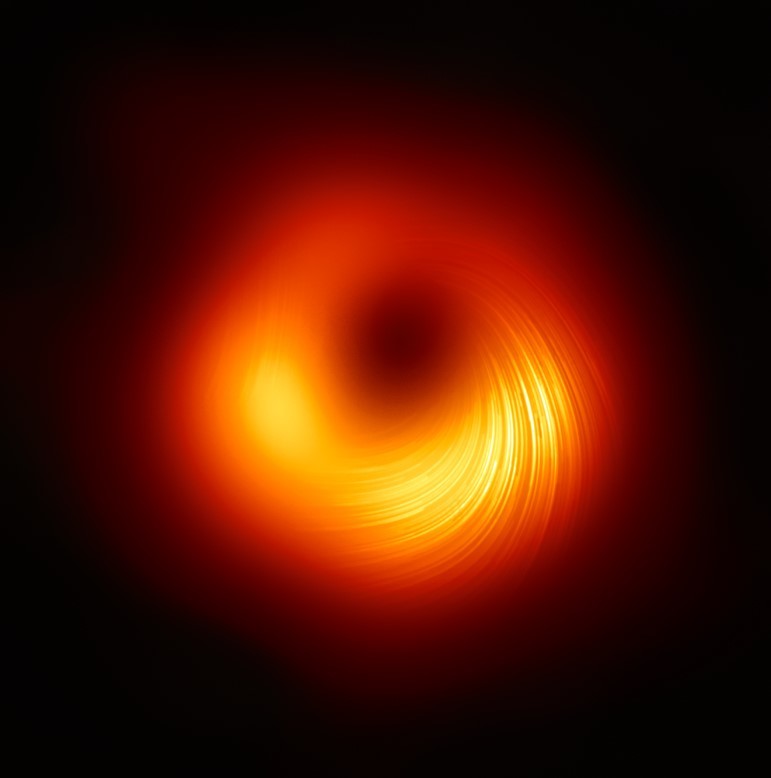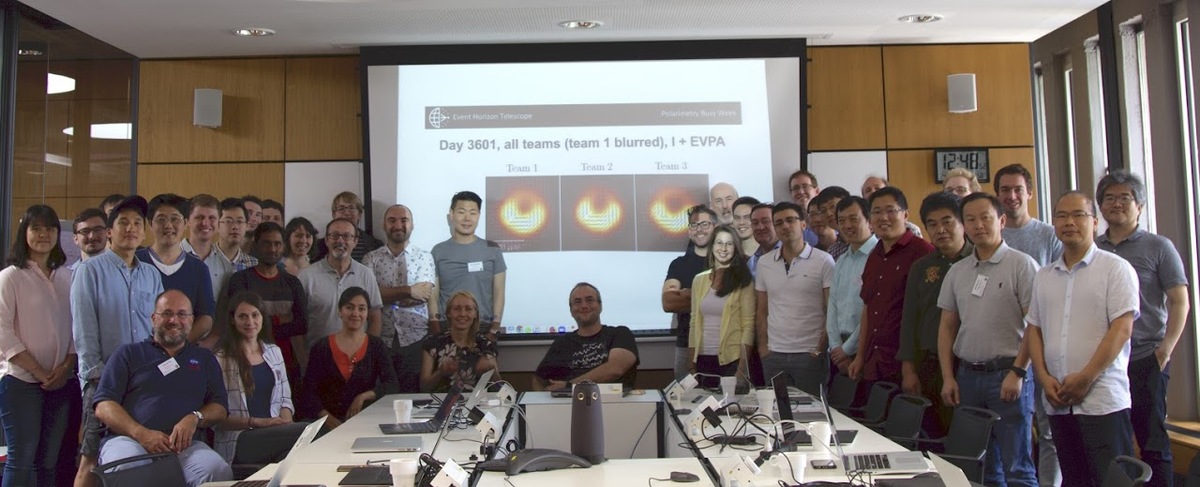Second-ever image of black hole is out!



2021-04-12
The second-ever image of a black hole is finally out! The international collaborative project – Event Horizon Telescope (EHT), of which Assistant Professor Cheng-Yu Kuo of the Department of Physics at NSYSU is a member, has just published the latest polarised-light image of a black hole in the center of M87 Galaxy. This important milestone will help analyze the structure of the magnetic fields around black holes. The results of the team's research were published on March 24th in The Astrophysical Journal Letters.
The black hole at the center of M87 Galaxy, spewing enormous jets of matter, is one of the most mysterious and exciting features of the galaxy. It is now known that these jets are related to the strong magnetic field around the black hole. How the matter falls into the black hole and how it gets spewed out are some of the most interesting topics in astrophysics today. Following the unveiling of the first-ever image of a black hole in 2019, this time, the EHT attained a polarised-light image of the black hole in M87 Galaxy. The polarised-light image shows the magnetic field around the black hole. By observing the shadow of the black hole in polarised light, astrophysicists can obtain more information on the distribution of the magnetic field surrounding the black hole.
Assistant Professor Cheng-Yu Kuo of the Department of Physics at NSYSU, who is a member of EHT Polarimetry Working Group, said that although the black hole shadow image itself proves the existence of the black hole, it cannot provide too much information about the physical mechanisms of black holes, such as how they swallow gases and create jets. He explained that people knew about the existence of prominent jets a hundred years ago already, and came up with many related theoretical models. This time, through the observation of the numerical values and information of the polarized light of M87 Galaxy, scientists can learn about the distribution and strength of the magnetic field around the black hole and compare their observations with theoretical models. In addition, there are more galaxies and black holes that continually create jets. He hopes that EHT’s research can find a further application and bring in a more comprehensive analysis and understanding of black holes.
Professor Kuo said that because the polarised light signal is very weak, it is very difficult to process all the data and that the Taiwanese members of EHT spent a lot of time and energy reviewing and analyzing the data to obtain this valuable polarized-light image. One of the coordinators of the EHT Theoretical Models and Simulations Working Group, Associate Professor Hung-Yi Pu of the National Taiwan Normal University said that Taiwan’s EHT team has been researching how the matter is sucked into and spewed out of the black hole. He also said that this polarised-light image of the black hole, besides revealing the matter around the black hole in M87 Galaxy and its radiation properties, is also compatible with the speculated characteristics of the black hole based on the image revealed in 2019. Another coordinator of the EHT Polarimetry Working Group, researcher of the University of Valencia in Spain Ivan Marti-Vidal explained that in the past, achieving a polarized-light image would take several years, and the technologies for obtaining and analyzing these data were fairly complicated, while the information brought by polarized light can allow us to further understand the physics behind the first image of a black hole.
Coordinator of the EHT Polarimetry Working Group, Monika Mościbrodzka – Assistant Professor at Radboud University in the Netherlands, said that this image helps us understand the specific behavior of the magnetic field of the black holes, and how the black hole in M87 Galaxy spews the matter from its core outwards to outside of the galaxy. “These observations by EHT have made our wish come true!” Asada Keiichi, EHT science council member and Associate Research Fellow at the Institute of Astronomy and Astrophysics (IAA), Academia Sinica, said that to understand the formation of black hole jets, the IAA team has been observing the magnetic fields around black holes for over 10 years. In 2017, IAA joined the Event Horizon Telescope project, which uses 8 telescopes from around the world, combining their power to create a virtual Earth-sized telescope with a high resolution for the team to directly observe the shadow of the black hole and its surrounding bright ring, and the latest unveiled polarized-light image clearly shows how the bright ring is magnetized.
The second-ever image of a black hole is finally out! The international collaborative project – Event Horizon Telescope (EHT), of which Assistant Professor Cheng-Yu Kuo of the Department of Physics at NSYSU is a member, has just published the latest polarised-light image of a black hole in the center of M87 Galaxy. This important milestone will help analyze the structure of the magnetic fields around black holes. The results of the team's research were published on March 24th in The Astrophysical Journal Letters.
The black hole at the center of M87 Galaxy, spewing enormous jets of matter, is one of the most mysterious and exciting features of the galaxy. It is now known that these jets are related to the strong magnetic field around the black hole. How the matter falls into the black hole and how it gets spewed out are some of the most interesting topics in astrophysics today. Following the unveiling of the first-ever image of a black hole in 2019, this time, the EHT attained a polarised-light image of the black hole in M87 Galaxy. The polarised-light image shows the magnetic field around the black hole. By observing the shadow of the black hole in polarised light, astrophysicists can obtain more information on the distribution of the magnetic field surrounding the black hole.
Assistant Professor Cheng-Yu Kuo of the Department of Physics at NSYSU, who is a member of EHT Polarimetry Working Group, said that although the black hole shadow image itself proves the existence of the black hole, it cannot provide too much information about the physical mechanisms of black holes, such as how they swallow gases and create jets. He explained that people knew about the existence of prominent jets a hundred years ago already, and came up with many related theoretical models. This time, through the observation of the numerical values and information of the polarized light of M87 Galaxy, scientists can learn about the distribution and strength of the magnetic field around the black hole and compare their observations with theoretical models. In addition, there are more galaxies and black holes that continually create jets. He hopes that EHT’s research can find a further application and bring in a more comprehensive analysis and understanding of black holes.
Professor Kuo said that because the polarised light signal is very weak, it is very difficult to process all the data and that the Taiwanese members of EHT spent a lot of time and energy reviewing and analyzing the data to obtain this valuable polarized-light image. One of the coordinators of the EHT Theoretical Models and Simulations Working Group, Associate Professor Hung-Yi Pu of the National Taiwan Normal University said that Taiwan’s EHT team has been researching how the matter is sucked into and spewed out of the black hole. He also said that this polarised-light image of the black hole, besides revealing the matter around the black hole in M87 Galaxy and its radiation properties, is also compatible with the speculated characteristics of the black hole based on the image revealed in 2019. Another coordinator of the EHT Polarimetry Working Group, researcher of the University of Valencia in Spain Ivan Marti-Vidal explained that in the past, achieving a polarized-light image would take several years, and the technologies for obtaining and analyzing these data were fairly complicated, while the information brought by polarized light can allow us to further understand the physics behind the first image of a black hole.
Coordinator of the EHT Polarimetry Working Group, Monika Mościbrodzka – Assistant Professor at Radboud University in the Netherlands, said that this image helps us understand the specific behavior of the magnetic field of the black holes, and how the black hole in M87 Galaxy spews the matter from its core outwards to outside of the galaxy. “These observations by EHT have made our wish come true!” Asada Keiichi, EHT science council member and Associate Research Fellow at the Institute of Astronomy and Astrophysics (IAA), Academia Sinica, said that to understand the formation of black hole jets, the IAA team has been observing the magnetic fields around black holes for over 10 years. In 2017, IAA joined the Event Horizon Telescope project, which uses 8 telescopes from around the world, combining their power to create a virtual Earth-sized telescope with a high resolution for the team to directly observe the shadow of the black hole and its surrounding bright ring, and the latest unveiled polarized-light image clearly shows how the bright ring is magnetized.
Click Num:
Share
